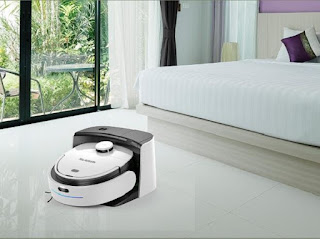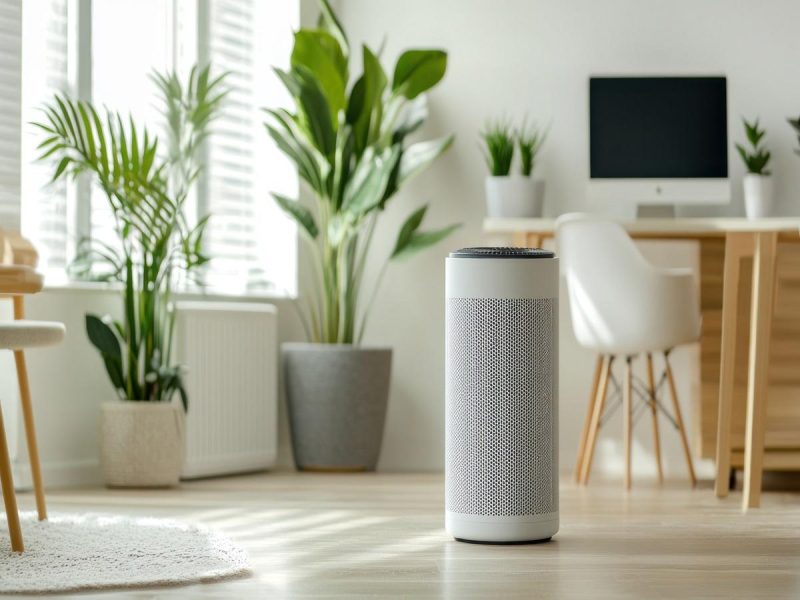Consistent, never on leave, working without supervision. Corona times have led to spurt in automated devices that mop, scrub and vacuum your house unobtrusively
We have sold 5,000 units in last three months and are currently out of stock, says a prominent manufacturer of robotic vacuums retailing in India. Jittery about maids entering homes and, in a bid to become self-reliant, educated elites in metros are increasingly opting for automated cleaners. It’s machines over man (maid in this case, if you will) as people try to minimise human interface.
Akhilee Malhotra, a 45-year-old resident of a premium gated community who recently bought an iRobot for her 4BHK apartment, says, “We are at the edge of the desert in Gurugram, what with Rajasthan being next-door. Plus, we have pets. As a labour-saving device, the robot is a good investment for keeping the dog dander and dust down.”
Malhotra loves the way the “little monster” wades its way through the house, gobbling up everything from dust bunnies, fur balls and even the bread crumbs from last night’s dinner.
Her husband Ajay says he had mixed feelings about using the robots the first time he programmed their “work” schedules. Says he: “Robotics have changed my house cleaning and need I say robot technology may soon be appearing in the average home for cleaning, cooking and doing all the chores. Makes me think of the sheriff’s “smart house” in the TV series Eureka where it cleans, cooks, makes beds, organises the owner’s schedule, and notifies people he has appointments with.”
Premium purchases such as vacuum cleaners and dishwashers, which are “intent driven” categories related to cleanliness and hygiene and help promoting DIY culture, will sustain even beyond the pandemic, as per recent studies. Says Vishnu Vardhan, consultant, Euromonitor International: “Consumers will look for ways to simplify their lives at home. They are reprioritising their purchases and would rather buy fewer but high-quality tech devices that help one in becoming self-sufficient and getting rid of domestic help.”
Robots in the market
The key brands manufacturing and retailing robotic vacuums in India include iRobot Milagrow, Cecotech, Ecovacs, I-Lite, i-lifecare, LG. Roomba and Braava M6 by iRobot, Deebot by Ecovacs, and I-map and Seagull by Milagrow are some of the bestselling robotic vacuums in the market. Most of these are sold directly through their company portals but many have a presence on other e-commerce platforms. Says a spokesperson from I-lifecare, “We are available on Croma, Reliance Digital and Amazon. We will also be part of Flipkart’s Big Billion festive sale starting October 15.”
Then there are others like Dyson and Eureka Forbes that primarily have manual vacuum cleaners. Says Vineet Taneja, President, APAC at Dyson, “I am afraid we don’t sell our robot range in India. But we do have a range of cord-free vacuum cleaners that actually do a better job since they are able to clean all types of surfaces.”

This iRobot Braava M6 mopping robot cleans in an efficient pattern while navigating around furniture, rugs, under beds. Price: Rs 59,900
What exactly is a robotic vacuum?
Simply put, a robotic vacuum has a small motor that propels it to move around the house on wheels, turning brushes or rollers that kick up debris–all this as the suction pulls it into their internal dustbin. Most models have Wi-Fi connectivity, allowing machines to self-operate. The advanced versions can map rooms on their own, leave from and return to a docking station that doubles as a battery charger.
What are the functions you should expect a robotic vacuum to typically perform? First is to vacuum or suck up all dust and dirt particles. Second is to sweep the floor by moving dust and dirt particles to one side of the room. Third is to mop and do wet cleaning of the floor while fourth is scrubbing on one location continuously to remove hard strains. A robot can have either of these or all four, such as Cecotec cleaners that come with 4-in-1 capability of vacuuming, sweeping, mopping and scrubbing. Says a Cecotec spokesperson: “We have developed a ‘special Indian Customer need centric Robot Floor Cleaner’ as we understand that mopping and scrubbing are part of the day-to-day cleaning routine of an Indian household.”
Step by step
How do you get started and what is the exact process? Once you get the machine home, you need to first charge it fully. Once you switch on the device, it will take 2-3 seconds to map the whole area of the house, and then create blocks. Say, it will divide the 1,300 sq ft of area into four different blocks and start cleaning block wise. You can configure it on your mobile phones. All devices have their mobile apps and the handset doubles up as the point of control and the interface on which you can watch the cleaning. They show you the map of how much is cleaned and what is not covered. In top-end models, the robot remembers the complete map.
How much time does a robot take to clean the full house? According to Pulak Satish Kumar, Director, COO, Puresight Systems Pvt Ltd, the official distributor of iRobot products in India, “In order to clean 1,500 sq ft area, it would require about 90 minutes. However, it may vary depending on the obstacles on the floor, the kind of furniture etc. The iRobot Home App gives you complete control from anywhere, letting you schedule, customise, and select the rooms you want cleaned. The device comes with a warranty of two years.”
The robots are usually present in three variants- basic, mid-end and advanced. Says K Samarth, Marketing Manager, Milagrow: “At the top end is the technology which is fully independent in terms of navigation, it can self-clean the house. In the middle, is a technology that is not independent but is good enough. At the bottom is the least independent technology, but it is good for small houses.” Milagrow Robotics has Milagrow iMap Max for Rs 99,990, which is a fully independent, self-cleaning robotic vacuum with a patented wet mopping mechanism. The iMap 10.0 priced at Rs 89,990, comes with iMap LIDAR, which can form real-time maps by scanning up to 16 metres, and has as many as 18 sensors allowing the robot to plan its path fast and display cleaned and left out areas in real-time on the user’s mobile screen. Milagrow Seagull is the entry model at Rs 20,000, which comes in a height of just 7.2 cm and uses the ‘Gyro Mapping’ technology to determine orientation and display real time progress while cleaning on the user’s device.
What about bathrooms? They are tricky business as they have ‘still’ water. According to Rajeev Karwal, Founder, Milagrow Robots, “If the layer of water in the bathroom is very thin, then Milagrow’s IMAP max can mop it and also self-clean the mop. We can also use disposable dust bags with this Milagrow robot, while for other models it is not advised. Usually, no robots will be able to suck water without making the dry dirt in the dustbin sticky.”
Choosing your kind of robot
There are a few questions you must ask yourself before selecting a robotic vacuum. Is your need only for dry or wet mopping or for both? You must consider the size of your home, the number of carpets and pets, if any, as they are big sources of dust. Also, is the furniture expensive and do you have too many antique pieces at home?
One thing common to most robotic vacuum cleaners are that they are anti-fall and anti-obstruction; so, they will not fall down from the stair and if there is any obstruction that comes in the way, they will find a way around it.

Milagrow Seagull is an entry model with a height of 7.2 cm. Its ‘Gyro Mapping’ technology determines orientation, and displays real-time progress and maps on the user’s handset. Price: Rs 20,000
Why buy a robot?
“Independent navigation is the biggest reason,” says Milagrow’s Samarth. “People usually want something they can leave for house cleaning, without surveillance. The other reason is deep cleaning. Many of our customers have asthma and respiratory allergies and this vacuum gobbles up all germs and pollen and leaves the home safe and hygienic.”
What are the questions the buyer needs to ask while surveying the brands? The buyer needs to know the height of the robot, and whether it can get under the beds and sofas. Information on after sales service, warranty period, policy on replacement of parts and accessories (as wear and tear is a given) must also be sought. According to a spokesperson from I-lifecare, “Three things you need to change include the Hepa filter (4-5 months), the side brushes (6-7 months), mopping cloth made of microfibre (2-3 months)- each of which comes for Rs 200-250. The lithium-ion battery runs up to four years and costs Rs 2,500. One should ask the seller how often the battery needs to be changed and what it costs. Some imported products have batteries that need to be changed every two years and cost upwards of Rs 5,000.
Like everything else, this technology has its own set of upsides and downsides. Users claim that their floors have never been this clean and the cleansing process tends to increase the life of the asset. Says Bengaluru-based software professional Vikas Mehta: “The biggest relief is that it does things independently. Imagine relaxing with a cup of coffee on a Saturday morning as your vacuum runs itself underneath the sofa and media console, sucking in the dust. An hour later, it beeps to let you know it has completed its rounds. You triumphantly check one chore off your to-do list without having broken a sweat. Often emptying the Roomba dustbins become something of a family event, where we marvel at how much dust and dirt the Roomba has managed to sweep up.”
But not everything is so hunky dory. You need to charge the battery each time you set it for cleaning. Even the best robot vacuums do get stuck occasionally, despite their optical sensors and ability in pricier models to map your home’s floor plan. They may sometimes end up sucking power cords, shoelaces, and speaker cables, so you need to make your house robot-compliant before starting the cleaning cycle and pick any loose cables off the floor or close closet doors to keep precious stuff hidden.
You need to empty the dustbins regularly and clean the brushes by removing its roller, cleaning out the debris and hair that gets wrapped around its bristles. If too much hair builds up in your robot, it could be permanently damaged. Also, entry models tend to work in a random way and there is no predefined path – sometimes repeating or missing out on a few areas in the house.
The other downside is that this becomes the beginning of your journey to go “Mission Clean” and dependence in a way on machines, instead of maids. People who buy robots for the floor are often tempted to buy glass-cleaning and swimming pool cleaning robots, and automated lawn-mowing devices. Like the case of US citizen Sukhbir Singh, who owns two robot vacuum cleaners. Why two? He says, ‘Two because my cats love to ride on them. They work day and night to keep down cat hair and pollen. My garden has another robotic unit that cuts the grass. The turkeys hate it and chase it everywhere.”
Table: What a robotic vacuum for your house will cost you
|
Manufacturer |
Models |
Price |
|
iRobot |
iRobot cleaning robots start at Rs 26,900 and go up to Rs 149,900. The Braava M6 comes for Rs 54,900 |
Rs 26,900-1,49,900 |
|
Ecovacs |
ECOVACS Deebot 500,Ecovacs Deebot Ozmo T8 AIVI Robot Vacuum Cleaner |
Rs 27,900-1,34,999 |
|
Milagrow |
Milagrow Seagull Floor Robot (Rs 20,000), Milagrow iMap 10.0 (Rs 89,990), Milagrow iMap Max (Rs 99,990) |
Rs 20,000-1,20,000 |
|
Cecotech |
Conga 1090 Connected, Conga 1590 Active, Conga 3290 Titanium,Conga 4090 |
Rs 23,900-59,900 |
|
LG HomeBot |
LG 1 Litre Robotic Vacuum |
Rs 49,090 |
|
Dyson |
Dyson V11 Absolute Pro (Nickel/Blue), Dyson V7 Trigger |
Rs 19,900-52,900 |
|
I-Lifecare |
A9s, V80 |
Rs 16,700-31,700 |
|
Eureka Forbes |
RV201 Robotic Vacuum Cleaner |
Rs 29,990 |
Credit: Market Research




